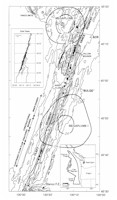
U.S. Dept. of Commerce / NOAA / OAR / PMEL / Publications
Introduction
In 1986, an anomalously large hydrothermal plume was discovered over the northern Cleft segment of the southern Juan de Fuca Ridge (Figures 1 and 2) [Baker et al., 1987]. The "megaplume," as it came to be known, contained a thermal discharge of about 10161017 J and had a distinct hydrothermal chemical signature [Baker et al., 1987, 1989]. Another megaplume (Megaplume II) was discovered overlying the Vance segment about 40 km north of the first megaplume in 1987. The rise height and size of the megaplumes strongly imply that they were transitory features related to the sudden breaching of a hydrothermal reservoir, probably a seafloor rifting event [Baker et al., 1989]. Although the source of the megaplumes could not be determined during the water column surveys, the occurrence of less intense, deeper, and more "steady state" hydrothermal plumes over the adjacent ridge crest suggested a likely source area. An investigation of this area using sidescan sonar, a towed-camera, continued water column surveys, and submersible dives followed over the next several field seasons. The purpose of the surveys was to define the volcanic, tectonic, and hydrothermal characteristics of the ridge crest from which the megaplumes originated in order to constrain the possible source mechanisms. The most significant result of this work was the discovery that a volcanic eruption occurred at this site between 1983 and 1987, strongly implying a link to the megaplumes [Embley et al., 1990a; Chadwick et al., 1991; Fox et al., 1992]. Embley et al. [1991] presented an initial description of the geology of this area, but Chadwick and Embley [this issue] and we (1) describe the geologic setting of the southern Juan de Fuca Ridge, (2) present detailed observations of the hydrothermal, tectonic, and volcanic relationships along the northern Cleft segment, and (3) present an interpretation of the sequence of events that took place in this area during the past decade and the implications for processes on ridge crests.
Figure 1. Simplified Sea Beam map of portion of area of Plate 1 showing features discussed in text. Contour interval is 100 m except for the axial valley, where it is 20 m. Temperature anomaly contours of megaplumes are from Baker et al. [1989]. Solid line from 44°35'N to 44°42'N is location of cleft [after U.S. Geological Survey Juan de Fuca Study Group, 1986]. Locations of new pillow mounds and young sheet flows are indicated. Stars show location of high-temperature vents. SCR is Split Cone Ridge. Index map at lower right shows location of mapped area. Inset at upper left shows locations of NOAA towed camera tracks made between 1987 and 1991. A-B shows location of along-axis bathymetric profile shown on Figure 2.
Figure 2. Along-axis bathymetric profile of Cleft segment (A-B) constructed from 100-m grid. Location shown in Figure 1. Dashed line shows gradient of portion of north rift zone of the Krafla central volcano, Iceland.
Return to Abstract or go to next section